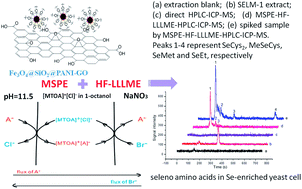A dual extraction technique combined with HPLC-ICP-MS for speciation of seleno-amino acids in rice and yeast samples†
Abstract
Magnetic solid phase extraction (MSPE) was combined with hollow fiber liquid liquid liquid microextraction (HF-LLLME) for the extraction of seleno-amino acids. Graphene oxide (GO) modified magnetic nanoparticles (MNPs) were prepared and loaded with Cu2+ for the adsorption of target seleno-amino acids based on the interaction between Cu2+ and seleno-amino acids. Aqueous ethylenediamine was employed as the desorption solvent, and the desorption solution was directly employed as the donor solution in the subsequent HF-LLLME procedure for further preconcentration of target seleno-amino acids. In HF-LLLME, 1-octanol was employed as the extraction solvent, ionic liquid trioctylmethylammonium chloride ([MTOA]+[Cl]−) was employed as the carrier for the extraction of target seleno-amino acids, and aqueous NaNO3 solution was employed as the acceptor solution. The target seleno-amino acids were extracted from the donor solution into the organic phase and then back into the acceptor solution under the driving force of ion-pair formation between target seleno-amino acids and [MTOA]+[Cl]− and the gradient counter ions between the donor phase and the acceptor phase. Various factors influencing the extraction of target seleno-amino acids by MSPE and HF-LLLME were investigated thoroughly. Based on it, a method of MSPE-HF-LLLME coupled with high performance liquid chromatography (HPLC)-inductively coupled plasma mass spectrometry (ICP-MS) was developed and the analytical performance was evaluated under optimized conditions. After preconcentration by MSPE-HF-LLLME, the enrichment factors (EFs) for target seleno-amino acids ranged from 152 to 278-fold, and the LODs for target seleno-amino acids were in the range of 0.0075–0.013 μg L−1. A certified reference material of SELM-1 was used to validate the accuracy of the proposed method, and the determined value of SeMet was in good agreement with the certified values. The proposed method was successfully applied to the speciation of seleno-amino acids in rice and Se-enriched yeast cell samples.

- This article is part of the themed collection: 2015 Asia Pacific Winter Conference on Plasma Spectrochemistry, Xiamen, China

 Please wait while we load your content...
Please wait while we load your content...